Table of contents
- Nine 48 hp motorcycles put to the test Motorcycles and scooters for driving license class A2
- Driving license class A2
- Honda CBR 500 R.
- For the little ones to climb carefree
- Moto Guzzi V7 Special
- Guzzi with easy-care cardan
- Kawasaki ER-6n
- Decent smoothness, impeccable throttle response
- Aprilia Shiver 750 ABS
- Aprilia is only electronically throttled
- BMW G 650 GS
- BMW G 650 GS for the civilized connoisseur
- Triumph Street Triple
- Nothing is missing there
- Honda NC 700 X
- Just do what the driver wants
- Kawasaki Ninja 300
- Bonsai Racer goes one step further
- Yamaha TMax 530 ABS
- Doesn’t spoil when you start the traffic light
- throttling
- Throttle kits for over 200 motorcycles
- Intervention in the control unit can lead to side effects
- Prices and offers for top-proven A2 motorcycles in Germany
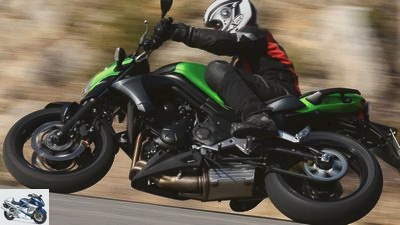
Jahn
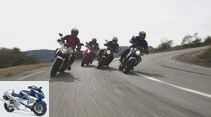
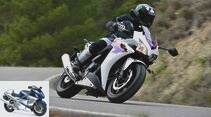
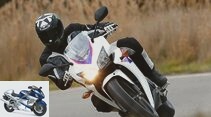
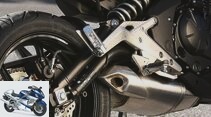
44 pictures

Jahn
1/44
Thanks Brussels: With the new tier driving license for young drivers and newcomers, the EU has given a hefty surcharge of 14 HP to the previous 34: Motorcyclists from the age of 18 are now allowed to drive machines with up to 48 HP (35 kW). A horsepower plus of 40 percent. We’re showing nine of these new entry-level motorcycles.
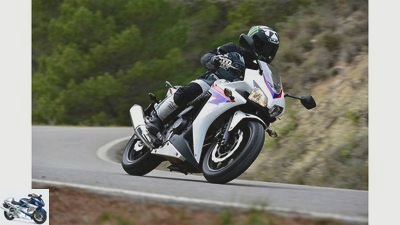
manufacturer
2/44
Honda CBR 500 R: The youth can breathe easy. So are the young at heart.
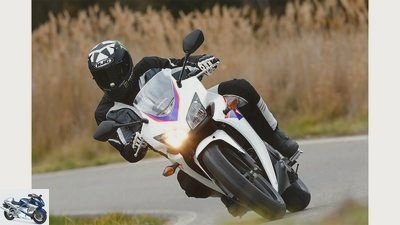
manufacturer
3/44
Honda CBR 500 R: The Honda CBR 500 R is an attractive half-liter racer that is far removed from boredom and lack of character. That sucks!
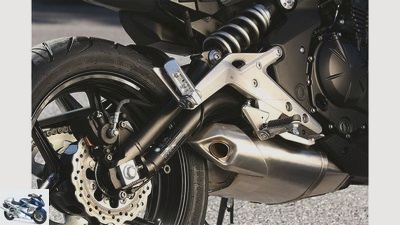
Jahn
4/44
Kawasaki ER-6n: The swing arm consisting of two pipe loops is one of the distinctive features of the Kawasaki ER-6n.

Jahn
5/44
Kawasaki ER-6n: The Kawa ER-6N with originally 72 HP confirms this thesis – it turns up willingly, pulls through well and is economical.
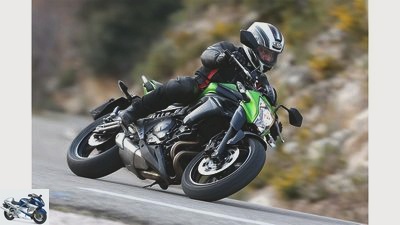
Jahn
6/44
Kawasaki ER-6n: The less power is cut, the better the throttle version behaves.
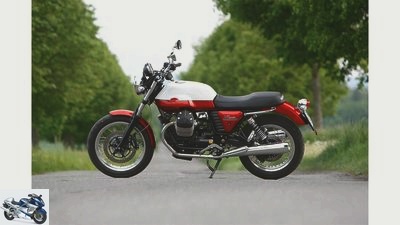
jkuenstle.de
7/44
Moto Guzzi V7 Special: What a shame, it would also look good on character actors.
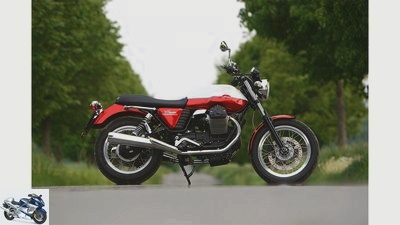
jkuenstle.de
8/44
Moto Guzzi V7 Special: The main drawback of all VZ is that there is unfortunately no ABS for Guzzi’s neo-classics.
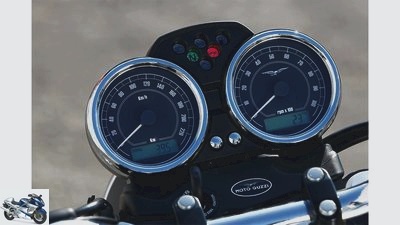
manufacturer
9/44
Moto Guzzi V7 Special: Classically drawn round instruments with integrated liquid crystal displays.
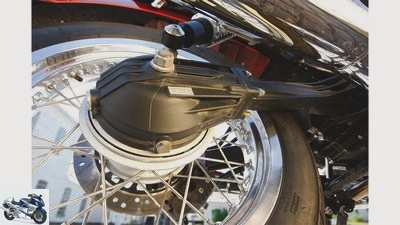
jkuenstle.de
10/44
Moto Guzzi V7 Special: Well done. A smoothly running cardan is a real specialty in the 48 hp class. Sparkling spoked wheels and chic two-tone paint are all the more.
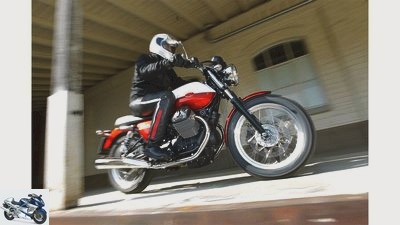
jkuenstle.de
11/44
Moto Guzzi V7 Special: Above all, the pretty 750cc Guzzi is really fun to drive.

jkuenstle.de
12/44
Moto Guzzi V7 Special: It has a glorious name, a sonorous V2 and a traditional, if modernized drive concept.
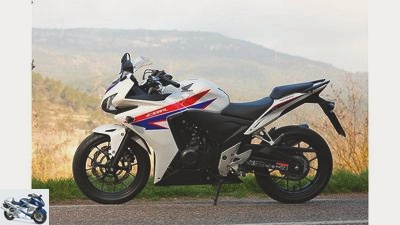
manufacturer
13/44
Honda CBR 500 R: The beginner-friendly driving experience, the remarkable handiness, the refreshing performance characteristics and the still low fuel consumption are definitely good reasons that speak for half the Fireblade.
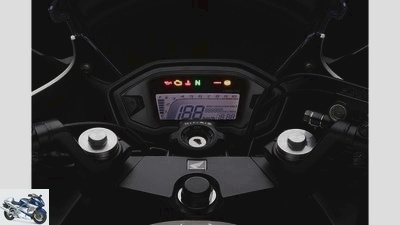
manufacturer
14/44
Honda CBR 500 R: The cockpit has a consumption display, the digital tachometer takes some getting used to.

manufacturer
15/44
Honda CBR 500 R: The single-disc brake with two-piston floating caliper and ABS provides great deceleration.
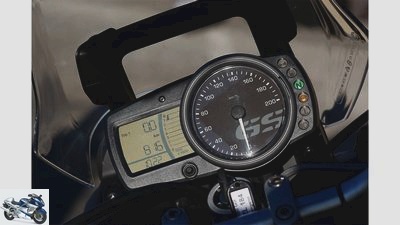
jkuenstle.de
16/44
BMW G 650 GS: The digital tachometer is a visual disaster.
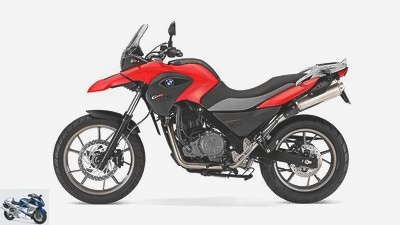
manufacturer
17/44
BMW G 650 GS: The BMW is a great rational motorcycle.
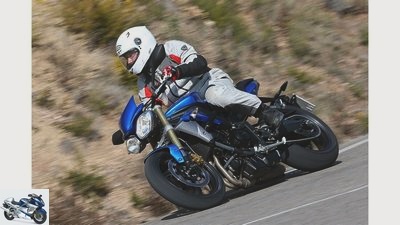
Jahn
18/44
Triumph Street Triple: The Streetie is throttled with a stop on the throttle valve mechanism.
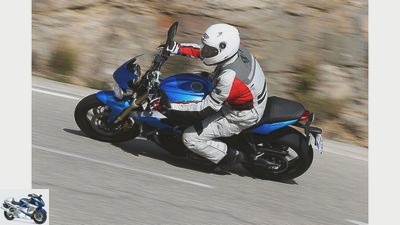
Jahn
19/44
Triumph Street Triple: This has less of an impact on driving pleasure than some think.

Jahn
20/44
Triumph Street Triple: Instead of a pair of silencers mounted under the rear, the Street Triple got a side silencer. That didn’t harm the three-cylinder sound.
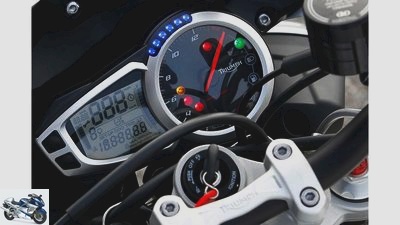
fact
21/44
Triumph Street Triple: The cockpit offers a lot of information in a small space.
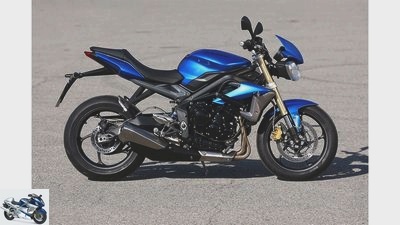
Jahn
22/44
Triumph Street Triple: The Street Triple is perfect for A2 driver’s license holders who do not want to buy a new motorcycle when purchasing the open A-license, but simply want to remove the stop.
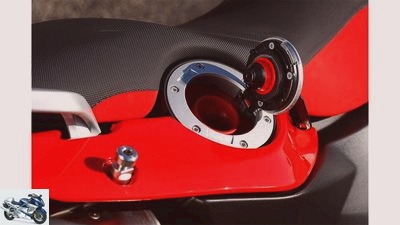
jkuenstle.de
23/44
BMW G 650 GS: The fuel is replenished from behind, the 14-liter tank is located below the seat.
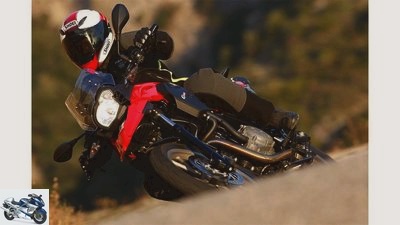
jkuenstle.de
24/44
BMW G 650 GS: With a lot of pressure from below and a lively performance characteristic, the BMW G 650 GS is a great entry into the stew class.
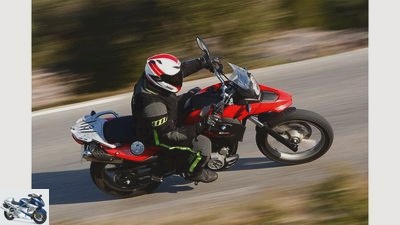
jkuenstle.de
25/44
BMW G 650 GS: A large single cylinder can not only seduce acoustically.
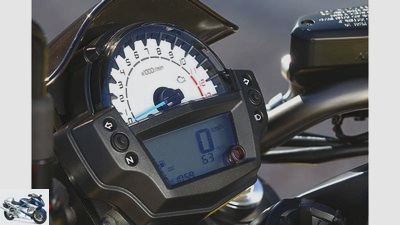
manufacturer
26/44
Kawasaki ER-6n: The stacked combination of analog and digital displays is also striking.
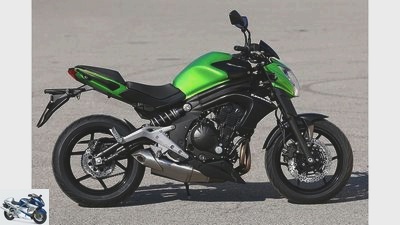
Jahn
27/44
Kawasaki ER-6n: The Kawa impresses above all with its wonderful handiness. When switching from other motorcycles, it almost seems too curvy, but then quickly turns out to be nicely balanced.
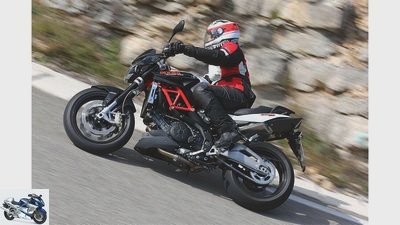
Jahn
28/44
Aprilia Shiver 750 ABS: When standing, it attracts attention. Wherever it drives by, you will find Motorklang benevolent listeners.
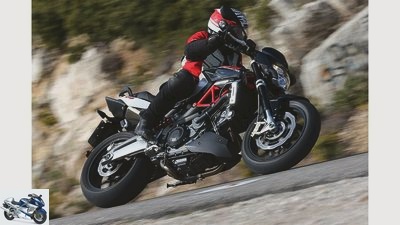
Jahn
29/44
Aprilia Shiver 750 ABS: And its powerful acceleration compensates for a good part of the lost turning pleasure.
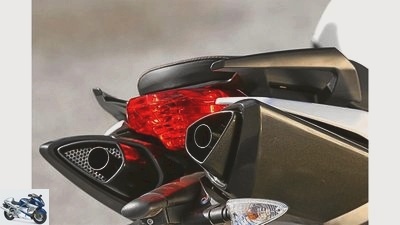
Jahn
30/44
Aprilia Shiver 750 ABS: The futuristically designed underseat exhaust system ensures a robust, pleasant sound.
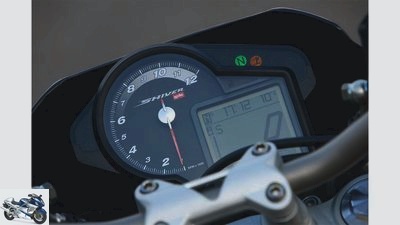
manufacturer
31/44
Aprilia Shiver 750 ABS: For the 48 hp version, only the range between 2000 and 6000 rpm is of interest on the tachometer.
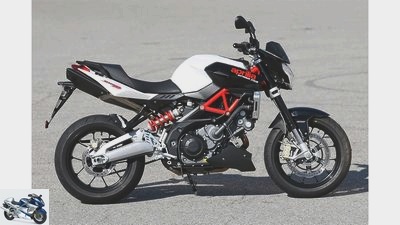
Jahn
32/44
Aprilia Shiver 750 ABS: Novice drivers don’t have it easy with the Shiver.
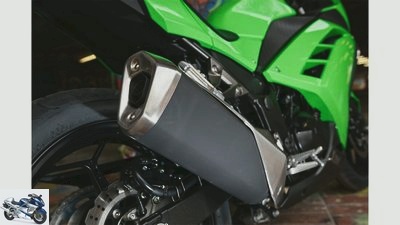
Jahn
33/44
Kawasaki Ninja 300: The heavily redesigned Bonsai Raxer is still convincing – and is even better than the previous model.
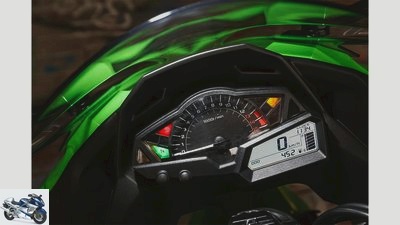
manufacturer
34/44
Kawasaki Ninja 300: The cockpit of the Kawa.
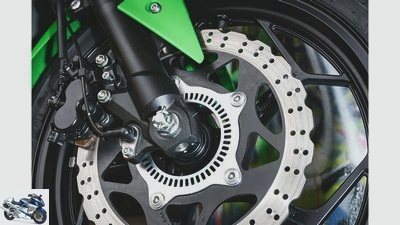
jkuenstle.de
35/44
Kawasaki Ninja 300: With ABS as standard, the 300 Ninja takes on new things and preserves the tried and tested with a high-revving engine (limit: 13,000 rpm).
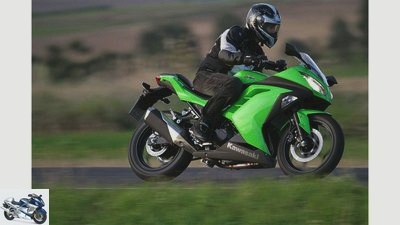
jkuenstle.de
36/44
Kawasaki Ninja 300: With a fresh look and larger displacement, the Ninja 300 appeals to sports freaks – even if the 39 hp Kawa cannot exhaust the 48 hp limit.
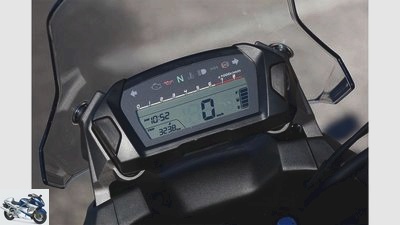
jkuenstle.de
37/44
Honda NC 700 X: The cockpit only offers the most necessary information.

jkuenstle.de
38/44
Honda NC 700 X: The dummy tank houses a 21 liter, excellently usable storage compartment.
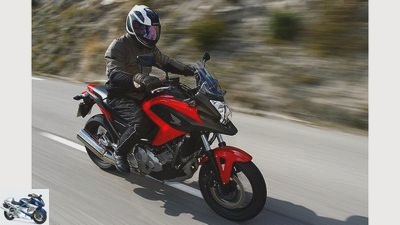
jkuenstle.de
39/44
Honda NC 700 X: Honda’s NC 700 X is predestined for newcomers and career changers – and a tempting offer for advanced users.
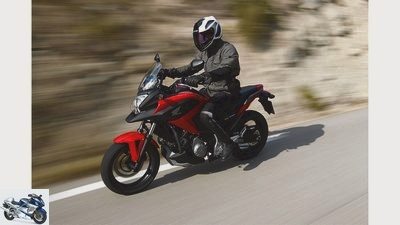
jkuenstle.de
40/44
Honda NC 700 X: adult appearance, solid all-round and everyday qualities.
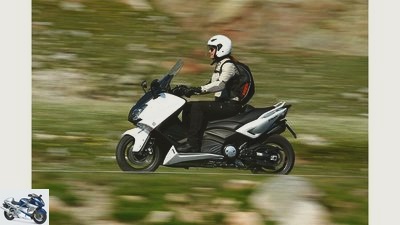
Gargolov
41/44
Yamaha TMax 530 ABS: Tens of thousands of southern Europeans can’t be wrong – or can they? Is the TMax sports scooter a useful alternative to a motorcycle for beginners?

manufacturer
42/44
Yamaha TMax 530 ABS: Of the TMax’s nominal 47 hp, only 40 reach the rear wheel via the toothed belt.
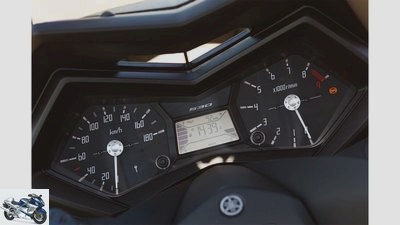
manufacturer
43/44
Yamaha TMax 530 ABS: The cockpit is reminiscent of the automotive industry and offers a lot of information.
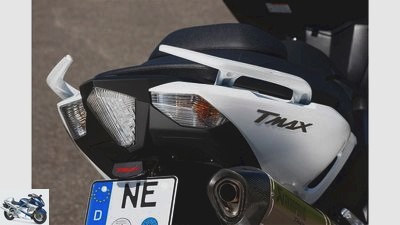
manufacturer
44/44
Yamaha TMax 530 ABS: The TMax has its justification – as a second vehicle for the city.
motorcycles
Nine 48 hp motorcycles tested for the A2 driver’s license
Nine 48 hp motorcycles put to the test
Motorcycles and scooters for driving license class A2
New and good: 34 + 14 = A2, the driver’s license class up to 48 hp. Young newcomers as well as older drivers benefit from it. We are testing the new 48 hp motorcycles: Honda NC 700 X, Kawasaki ER-6n, Aprilia Shiver 750 ABS, BMW G 650 GS, Triumph Street Triple, Kawasaki Ninja 300, Yamaha TMax 530.
Roman Kirschbauer, Peter Mayer, Ralf Schneider, Thomas Schmieder, Andreas Bildl, Michael Schumann
03/27/2013
Driving license class A2
Thanks Brussels: With the new tier driving license for young drivers and newcomers, the EU has given a hefty surcharge of 14 HP to the previous 34: Motorcyclists from the age of 18 are now allowed to drive machines with up to 48 HP (35 kW). A horsepower plus of 40 percent. Class. This makes great motorcycles suitable for beginners: roaring single-cylinder, dull, rumbling V2 machines, roaring three-cylinders and gently whispering four-cylinders. What they have in common: With all their character, they are not too heavy, do not appear castrated, but are really good fun.
Buy complete article
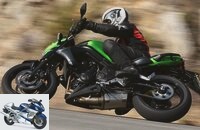
Nine 48 hp motorcycles put to the test
Motorcycles and scooters for driving license class A2
22 pages) as PDF
€ 2.00
Buy now
In order to enjoy the new driving fun, one must be at least 18 years old and acquire the newly offered driving license class A2. Or you are already in possession of the previous class A (limited) driving license. Holders of this old level driving license A, who were previously allowed to drive 34 hp, have been allowed to drive up to 48 since January 19 – completely unbureaucratic, without rewriting, just like that. After two years of driving experience, the 48 HP limit is no longer applicable for these drivers and the old A (limited) class is subject to an A driving license.
Ascent with an additional driving test: Driving lessons are not mandatory, but still necessary
This unbureaucratic elimination of the horsepower limit after two years in the entry-level class is only available if you have obtained your level driving license before January 19, 2013. Anyone who came or comes to the test afterwards and wants to drive openly according to A2 has to go back to the driving school: After two years, a 40-minute practical driving test is mandatory and must be completed on a machine with over 48 hp. Previous compulsory driving lessons are not required by law, but some will be necessary just to practice the basic driving tasks of the test. There are four compulsory: slalom at walking pace, emergency braking, evasive action, braking and evasive action.
Direct entry from the age of 24
A direct entry into the open class A, i.e. without a previous A2 driving license, is now possible under the new EU law from the age of 24. So far, the minimum age for this in Germany was 25 years.
New A2 with old car class 3
Older semesters also benefit from the new EU driving license. Anyone who got their car driver’s license (B, formerly 3) before April 1, 1980, automatically has class A1 for a maximum of 15 hp 125 cc. Prerequisite: The driver’s license must not have been withdrawn and reissued in the meantime. With class A1, you can now move up to class A2 without much effort, i.e. from a maximum of 15 hp 125 cc to a motorcycle with no displacement restrictions up to 48 hp. Registration at a driving school and a 40-minute practical test are required. Driving lessons are not required by law, but are essential in order to familiarize yourself with the large machine and to practice the basic driving tasks (see above). However, there is no need for theory lessons between 17-year-olds, overland, night or motorway double lessons. Costs depending on driving ability and required driving hours: from 450 euros.
In Germany, every type of motorcycle can be throttled
In addition to the maximum output of 48 hp, the EU Parliament has also stipulated the so-called power-to-weight ratio for motorcycles in the new A2 class: a motorcycle that can be driven with an A2 driving license may produce a maximum of 0.2 kW per kilogram. A 48 PS (35 kW) A2 motorcycle must therefore weigh at least 175 kilograms. Otherwise the engine has to be throttled until 0.2 kW per kilogram is reached again. This is why the KTM 690 Duke, which weighs 163 kilograms, produces only 32 kW (42.5 hp) instead of 35 in compliance with the A2 standard. The EU directives also stipulate that a motorcycle throttled to 48 hp should not more than double that in its original, open homologation may make a maximum of 96 hp. However, Germany has not implemented this passage in EU driving license law. Every motorcycle can be limited to 48 hp in compliance with A2, even a Suzuki Hayabusa.
Honda CBR 500 R.
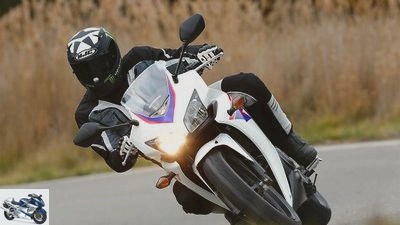
manufacturer
Honda CBR 500 R: The Honda CBR 500 R is an attractive half-liter racer that is far removed from boredom and lack of character. That sucks!
Finally the time has come. Blue sky, single-digit temperatures, the sun is slowly drying the still damp streets. Spring is in the starting blocks, the motorcycle license in your pocket. One would like to dare the really big thing right away. A Fireblade is sure to look good in the garage at home. Unfortunately, there are two limitations: the 48 hp regulation and the mediocre wallet. So why not go for half a liter? At 6255 euros, it costs less than half as much as a Fireblade, but it still looks like this from a distance. It’s a good compromise, isn’t it?
With a total weight of 196 kilograms, the CBR 500 R slim and, thanks to full fairing and stub handlebars, has enough sporty attitude for the beginning of a motorcyclist career. And as much as you are probably looking forward to the 1000 performance elite: Everyone starts small. This is a sensible idea, especially on a two-wheeler.
For the little ones to climb carefree
The Honda, which MOTORRAD was kindly allowed to borrow from dealer Auto-Hofle in Sindelfingen, makes it clear that low performance does not mean visual boredom, even before taking a seat on the two-part bench. Only when inspecting between the steel bridge frame does one recognize that the two-cylinder in-line engine is not the most fully-fledged example. But the drivers are not all the same size either. It is therefore good that the 79 centimeter seat height can be climbed carefree even for shorter people. It sits very compact on the 500. The extremities intuitively find the places intended for them. The slightly cranked handlebars bend the upper body a touch towards the front wheel, the footrest position only requires long-legged people over 1.80 meters to be willing to compromise. The knees bend with a sporty note – just comfortable enough for the country road lap. On longer tours you have to stretch your legs a little here and there to relax them. But what’s the complaint about? Let’s take this as a practice unit for the true super athlete. Because that’s not the CBR produced in Thailand. Or have you ever seen a super sports car with a telescopic fork without adjustment options?
To be fair, you have to keep in mind that the damping setting is well balanced for normal Otto drivers, not just with a view to the low price. As with the presentation in Valencia in mid-January, the suspension elements put in quite a lot without the motorcycle becoming uncomfortable or rocking worryingly on bumps. Despite the balanced damping setup, the spring elements acknowledge short impacts with poor response. The spine just has to vibrate a little. The spring strut is adjustable in the spring base, which creates the reserves necessary for two-person operation – although the pillion won’t last long on the narrow pillow. For this, the detent arms would have to sit even lower. Anyway, driving alone is more fun anyway!
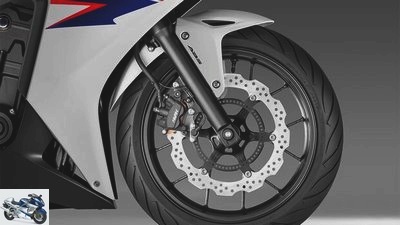
manufacturer
Honda CBR 500 R: The single-disc brake with two-piston floating caliper and ABS provides great deceleration.
Enough of the description: pull the non-adjustable clutch lever, press the starter button and listen to the 471 cubic centimeter counter-run. Hm, the two-in-one exhaust system doesn’t really puddle when the vehicle is stationary. That at least spares the neighbors’ nerves. The first gear also engages inaudibly. So, let’s go! With just over 2000 revolutions, the little racer starts cautiously and without hacking the chain. It’s amazing how quickly you shoot yourself in the motorcycle. After just a few kilometers, you have the feeling of being out and about with your best friend for years. Half the Fireblade can be directed playfully and requires anything but a lot of attention from its driver. Sit on it, concentrate on the road and enjoy driving. In contrast to the NC 700, the four-valve engine, which is significantly shorter-stroke, supports the carefree driving experience. But this is by no means monotonous. If you want to make rapid progress, you just have to turn the small engine a little higher. From around 5000 revs, there is a potent thrust and propel the CBR forward in a life-affirming manner. If the digital tachometer approaches the 7000 mark, a considerably vital afterburner kicks in. The half liter turns wonderfully lively into the limiter. The corners of the mouth go up. Especially since the Honda can convince with a subtle, but very liberated sounding two-cylinder sound in higher speed regions. So everything is fine?
A look at the single-disc brake while standing gave wings to the assumption that deceleration is probably not part of the CBR’s showcase discipline. But far from it! The Honda can be stopped very easily with little manual force. The ABS regulates precisely and effectively prevents overbraking.
So is the new Honda the secret star in the 48-hp sky? Unimportant! Because the beginner-friendly driving experience, the considerable handiness, the refreshing performance characteristics and the still low fuel consumption are definitely good reasons that speak for half the Fireblade. Especially with this attractive cost price.
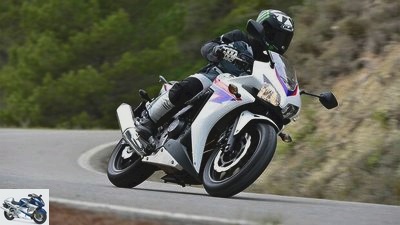
manufacturer
Honda CBR 500 R: The youth can breathe easy. So are the young at heart.
Technical specifications
engine
Water-cooled two-cylinder four-stroke in-line engine, two overhead, chain-driven camshafts, four valves per cylinder, bucket tappets, wet sump lubrication, injection, Ø 34 mm, regulated catalytic converter, 12 V / 9 Ah battery, mechanically operated multi-disc oil bath clutch, six-speed gearbox, O-ring chain.
Bore x stroke 67.0 x 66.8 mm
Cubic capacity 471 cm³
Compression ratio 10.7: 1
rated capacity 35.0 kW (48 hp) at 8500 rpm
Max. Torque 43 Nm at 7000 rpm
landing gear
Bridge frame made of steel, telescopic fork, Ø 41 mm, two-arm swing arm made of aluminum, central spring strut with lever system, adjustable spring base, double disc brake at the front, Ø 320 mm, double-piston floating caliper, disc brake at the rear, Ø 240 mm, single-piston floating caliper, ABS.
Cast aluminum wheels 3.50 x 17; 4.50 x 17
Tires 120/70 ZR 17; 160/60 ZR 17
Dimensions + weights
Wheelbase 1410 mm, steering head angle 64.5 degrees, caster 102 mm, spring travel f / r 108/119 mm, seat height 790 mm, weight with a full tank 196 kg, payload 177 kg, tank capacity 15.7 liters.
Warranty two years
Colors white, black
price including Nk 6255 euros
Readings
Performance
Top speed: 175 km / h (manufacturer information)
acceleration
0-100 km / h 5.5 sec
0-140 km / h 11.4 sec
Draft
60-100 km / h 6.4 sec
100-140 km / h 7.4 sec
Moto Guzzi V7 Special
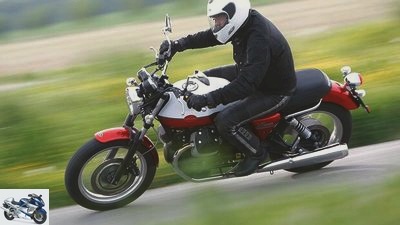
jkuenstle.de
Moto Guzzi V7 Special: It has a glorious name, a sonorous V2 and a traditional, if modernized drive concept.
It has a glorious name, a sonorous V2 and a traditional, albeit modernized drive concept. Above all, the pretty 750 Guzzi is really fun to drive.
Simply beguiling, this preppy Italian: her two-tone paint shines beautifully, the spokes of the light aluminum rims sparkle wonderfully in the sun. True to style on the V7 Also special are the polished aluminum fuel filler cap, classic round instruments and the elegant lines – a homage to Guzzi models from the early 1970s. As with the first V7 from 1967, the heart of the current 750 series is the V2 engine with 90 -Grad angle between the cylinders. They peek out seductively on the left and right under the touring 22-liter tank: With around four and a half liters of fuel consumption, there is a range of 500 kilometers.
Guzzi with easy-care cardan
The gearbox flanged directly to the lengthwise crankshaft and the easy-care cardan follow an ingeniously simple basic idea – a rarity in the 48 hp class. As it should be, there are chrome-plated manifolds and silencers on the left and right. The Guzzi sounds great. She snorkels in the air with a throaty throat and puffs out exhaust fumes with a pleasant thump. Really bassy. When accelerating while stationary, the crankshaft rotating transversely to the direction of travel first moves the delicate machine to the right before it rolls back into its vertical starting position. Technique that can be experienced and understood.
Even in the depths of the engine speed range, the engine really gets down to business: measured at just 2800 revolutions, the maximum torque is available: 59 Newton meters. Here the engine has the highest power in relation to the speed. Physics you can feel, on a gentle wave it goes forward. Strong and gentle. As in the past, only one inlet and one outlet valve each ventilate the two cylinders. Nevertheless, the injection engine was heavily revised in 2012. A central, computer-controlled throttle valve now provides the mixture to the Y-shaped intake tract. From an open 50 HP to 48 Cavalli, a small stop on the throttle valve cuts the peak performance. It limits their opening angle. Since March 2013, all V7 models and Nevada 750 have been delivered from the factory with 35 kW / 48 PS.
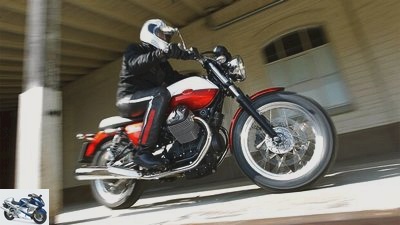
jkuenstle.de
Moto Guzzi V7 Special: Above all, the pretty 750cc Guzzi is really fun to drive.
A feather-light 199 kilograms with a full 202 kilograms payload allow the V7 to swing easily through the curves. Low weight, narrow tires and the installation position of the engine make them very handy. Everything is so easy. On mogul slopes, however, the cheap shock absorbers offer little comfort and reserves. Parts from the accessories trade promise a remedy. The V7 Special costs 8,490 euros. Much or little for truly dreamy moments? The V7 Stone with cast wheels and white or black matt lacquer is 500 euros cheaper. At the other end is the V7 Racer with a one-man hump, chrome-plated tank and start number plate for 9690 euros. The main drawback of all V7s: Unfortunately, there is no ABS for Guzzi’s neo-classics. It’s a shame, it would also look good on character actors.
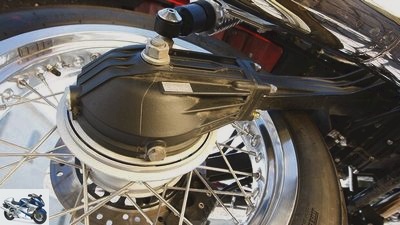
jkuenstle.de
Moto Guzzi V7 Special: Well done. A smoothly running cardan is a real specialty in the 48 hp class. Sparkling spoked wheels and chic two-tone paint are all the more.
Technical specifications
engine
Air-cooled two-cylinder four-stroke 90-degree V-engine, an underneath, chain-driven camshaft, two valves per cylinder, bucket tappets, bumpers, rocker arms, wet sump lubrication, injection, Ø 38 mm, regulated catalytic converter, 350 W alternator, 12 V / 14 battery Ah, mechanically operated single-plate dry clutch, five-speed gearbox, cardan, secondary ratio 4.125.
Bore x stroke 80.0 x 74.0 mm
Displacement 744 cm³
Compression ratio 10.5: 1
rated capacity 35.0 kW (48 hp) at 6200 rpm
Max. Torque 58 Nm at 5000 rpm
landing gear
Double loop frame made of steel, telescopic fork, Ø 40 mm, two-arm swing arm made of aluminum, two spring struts, adjustable spring base, front disc brake, Ø 320 mm, four-piston fixed caliper, rear disc brake, Ø 260 mm, double-piston floating caliper.
Spoked wheels with aluminum rims: 2.50 x 18; 3.50 x 17
Tires: 100/90 R 18; 130/80 R 17
Dimensions + weights
Wheelbase 1449 mm, steering head angle 62.5 degrees, caster 109 mm, suspension travel f / h 130/118 mm, seat height 805 mm, weight with a full tank 199 kg, load 202 kg, tank capacity 22.0 liters.
Warranty two years
Colors red / white
Price incl.nk 8490 euros
Readings
Performance
Top speed1 155 km / h
acceleration
0-100 km / h 6.1 sec
0-140 km / h 12.8 sec
Draft
60-100 km / h 5.6 sec
100-140 km / h 10.1 sec
Kawasaki ER-6n
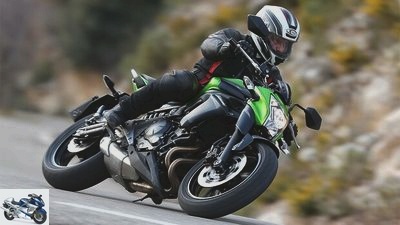
Jahn
Kawasaki ER-6n: The less power is cut, the better the throttle version behaves.
The less power is cut, the better the throttle version behaves. The Kawa ER-6N with originally 72 HP confirms this thesis – it turns up willingly, pulls through well and is economical.
What curves tell: The ER-6n engine in the 48 hp version develops its maximum torque very early, at 3600 rpm. This is not uncommon for a throttle engine like the Triumph Street Triple will still show. What is unusual, however, is the subsequent torque plateau – up to 7000 rpm, the curve is close to the maximum value – around 50 Nm.
You can feel that while driving. The 649 in-line twin-cylinder turns quickly and happily up to 9000 rpm, just as one would expect from a lively motorcycle engine. Acceleration and pulling power are absolutely on par with the class, the consumption of exactly four liters per 100 kilometers is only undercut by specially optimized fuel-saving masters.
Decent smoothness, impeccable throttle response
As a bonus, the Kawasaki decent smoothness, impeccable throttle response and a transmission that is easy to shift. It could go on like this.
It does it too, but only for drivers up to 1.70 meters tall. Normally shorter people have problems with motorcycles that are too tall, and Kawasaki has a fair amount of justice in this regard – to put it in a positive light. For taller pilots, the handlebar grips are too close to their bodies, the handlebars themselves are too narrow for that, and the whole ensemble forces an intimidated, retracted sitting posture. In addition, the seating position below the belt is pretty super sporty, as the driving photo suggests and the readings confirm. The driver’s footrests sit quite high, the seat hardly lower than on the ZX-6R or ZX-10R, which results in a very narrow knee angle.
In a direct comparison with other 48 hp motorcycles, the fork wasn’t really convincing either. With basically good coordination of suspension and damping, it was simply not sufficiently sensitive in the test motorcycle. Bumpy passages became quite a bumpy affair. The hindquarters also did not react as quickly as on the Triumph tested or even the tightly tuned Aprilia.
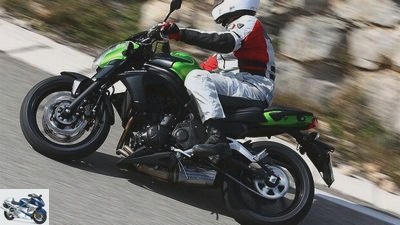
Jahn
Kawasaki ER-6n: The Kawa ER-6N with originally 72 HP confirms this thesis – it turns up willingly, pulls through well and is economical.
Motorcycles with ABS usually have a friction pairing of brake discs and pads that work with a healthy degree of sharpness. The reason is clear: if someone pulls too hard on the lever in a critical situation, the ABS prevents a fall. The Er-6n seems to have taken over its brake tuning from ABS-free times. It appears dull and only seems to slowly “wake up” when you brake frequently downhill. Snappy pads could work wonders here in terms of braking performance and controllability.
Despite these weaknesses, you can’t seriously be angry with the Kawasaki. This is due to their wonderful handiness. When switching from other motorcycles, it almost seems too curvy, but then quickly turns out to be nicely balanced. It can swing down to even tighter lines at any time, right down to deep slopes, and it dances through tricky curve combinations or evasive maneuvers with ease.
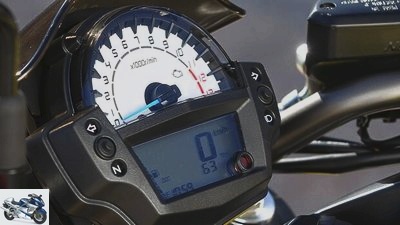
manufacturer
Kawasaki ER-6n: The stacked combination of analog and digital displays is also striking.
Technical specifications
engine
Water-cooled two-cylinder four-stroke in-line engine, a balance shaft, two overhead, chain-driven camshafts, four valves per cylinder, bucket tappets, wet sump lubrication, injection, Ø 38 mm, regulated catalytic converter, 336 W alternator, 12 V / 14 Ah battery, mechanically operated multi-disc oil bath clutch , Six-speed gearbox, O-ring chain, secondary ratio 46:15.
Bore x stroke 83.0 x 60.0 mm
Cubic capacity 649 cm³
Compression ratio 10.8: 1
rated capacity 35.0 kW (48 hp) at 8000 rpm
Max. Torque 55 Nm at 3800 rpm
landing gear
Bridge frame made of steel, telescopic fork, Ø 41 mm, two-arm swing arm made of steel, spring strut, directly articulated, adjustable spring base, double disc brake at the front, Ø 300 mm, double-piston floating calipers, disc brake at the rear, Ø 220 mm, single-piston floating caliper, ABS.
Cast aluminum wheels: 3.50 x 17; 4.50 x 17
Tires: 120/70 ZR 17; 160/60 ZR 17
Dimensions + weights
Wheelbase 1410 mm, steering head angle 65.0 degrees, caster 110 mm, suspension travel f / h 125/130 mm, seat height 805 mm, weight with a full tank of 208 kg, payload 198 kg, tank capacity 16.0 liters.
Warranty two years
Colors red, green, black
price including Nk 7175 euros
Readings
Performance
Top speed: 175 km / h (manufacturer information)
acceleration
0-100 km / h 6.0 sec
0-140 km / h 13.2 sec
Draft
60-100 km / h 5.6 sec
100-140 km / h 8.3 sec
Aprilia Shiver 750 ABS
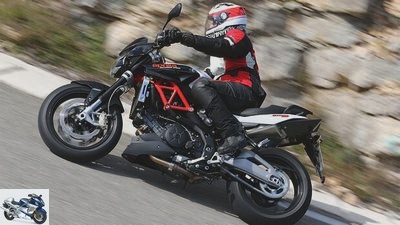
Jahn
Aprilia Shiver 750 ABS: When standing, it attracts attention. Wherever it drives by, you will find Motorklang benevolent listeners.
When standing, it attracts attention. Wherever it drives by, you will find Motorklang benevolent listeners. And their powerful acceleration compensates for a good part of the lost turning pleasure.
Aprilia is only electronically throttled
Of the motorcycles presented here, which in the original version developed more than 48 hp, is the only one Aprilia electronically throttled. Your throttle valves are operated by an electric motor at the command of the control unit and in the 48 hp version are never opened further than this power is reached.
Beyond the nominal speed of 5700 rpm, the power remains almost constant, but the torque curve naturally drops as the speed increases. In the area of 6500 rpm, the value drops below the mark that the Aprilia-V2 reaches at 3000 rpm – and that’s exactly how it feels when driving.

Jahn
Aprilia Shiver 750 ABS: The futuristically designed underseat exhaust system ensures a robust, pleasant sound.
So there is no point in turning the engine over 6000 rpm, except perhaps on a short straight between two bends if the driver wants to save two gear changes. The strength of the Aprilia engine lies in its powerful acceleration from medium speeds. The fact that it still cannot be driven lazily is due to the relatively small usable speed range and its long overall gear ratio, which is designed for 95 hp. This only serves to reduce consumption to a limited extent; The Shiver consumed 4.9 liters per 100 moderate kilometers driven – more than the Kawasaki (4.0) and the Triumph (4.7.)
In terms of load changes and throttle response, the two-cylinder behaves better than it has earned its reputation. However, this only comes to light on closer observation, because the chassis reacts strongly. Releasing the accelerator or applying it in an inclined position leads to immediate steering impulses, as does any unevenness in the ground. Even those who know the course of the route and act decisively cannot avoid constant slight rocking around the longitudinal axis. Anyone who hesitantly plays on the gas in corners, certainly not. And whoever applies the energetic brake in an inclined position, must counter-steer courageously and sensitively. Novice drivers don’t have it easy with the Shiver. The series tires of the type Dunlop Qualifier II are suspected. The testers would have liked to emphasize the qualities of the stable, firm, but pleasantly tuned chassis with precisely leading sports tires. Unfortunately, they weren’t available during the test drives in southern France.
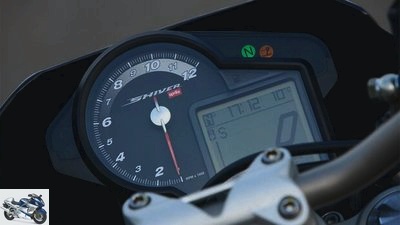
manufacturer
Aprilia Shiver 750 ABS: For the 48 hp version, only the range between 2000 and 6000 rpm is of interest on the tachometer.
Technical specifications
engine
Water-cooled two-cylinder four-stroke 90-degree V-engine, two each, gear / chain-driven camshafts, four valves per cylinder, bucket tappets, wet sump lubrication, injection, Ø 52 mm, regulated catalytic converter, 450 W alternator, 12 V / 10 Ah battery , hydraulically operated multi-disc oil bath clutch, six-speed gearbox, O-ring chain, secondary ratio 44:16.
Bore x stroke 92.0 x 56.4 mm
Cubic capacity 750 cm³
Compression ratio 11.0: 1
rated capacity 34.0 kW (48 hp) at 5250 rpm
Max. Torque 64 Nm at 5000 rpm
landing gear
Trellis frame made of steel with screwed cast aluminum parts, upside-down fork, Ø 43 mm, two-arm swing arm made of aluminum, spring strut, directly hinged, adjustable spring base and rebound damping, double disc brake at the front, Ø 320 mm, four-piston fixed calipers, disc brake at the rear, Ø 245 mm, single-piston -Swimming saddle, ABS.
Cast aluminum wheels 3.5 x 17; 6.0 x 17
Tires 120/70 ZR 17; 180/55 ZR 17
Dimensions + weights
Wheelbase 1440 mm, steering head angle 65.2 degrees, caster 109 mm, spring travel f / r 120/130 mm, seat height 810 mm, weight with a full tank of 225 kg, load 175 kg, tank capacity / reserve 15.0 / 2.5 liters.
Warranty two years
Colors black, white
price* including Nk 8690 Euro (* conversion costs: a matter of discretion of the dealer)
Readings
Performance
Top speed: 170 km / h
acceleration
0-100 km / h 6.0 sec
0-140 km / h 14.0 sec
Draft
60-100 km / h 5.7 sec
100-140 km / h 7.4 sec
BMW G 650 GS
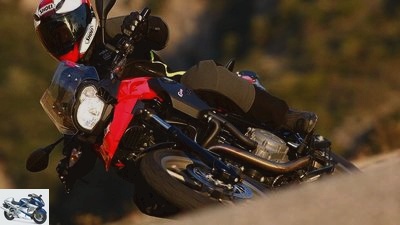
jkuenstle.de
BMW G 650 GS: With a lot of pressure from below and a lively performance characteristic, the BMW G 650 GS is a great entry into the stew class.
A large single cylinder can not only bewitch acoustically. With a lot of pressure from below and a lively performance characteristic, the BMW G 650 GS is a great entry into the stew class.
Nothing thuds nicer than a large-volume single cylinder. This fat pounding of a huge piston is unique. Even if the BMW G 650 GS is definitely not a Prolet acoustically, it can be immediately identified as a cylinder minimalist. Although its visual appearance may also give rise to arguments, the little BMW also has very sensible properties.
BMW G 650 GS for the civilized connoisseur
If you are young and wild and looking for adventure, you will hardly reach for this two-wheeler. It is rather something for the well-behaved connoisseur type who prefers solid technology and driving characteristics – which, however, does not mean that the moped is a lame snail.
After all, the GS weighs 198 kilograms, which you can feel when sitting at a height of 80 centimeters. The high center of gravity is noticeable here. From an ergonomic point of view, there is hardly anything to complain about. A very relaxed knee angle meets a wide handlebar. So you sit upright on the bike, but still integrated into it. Depending on how you turn it, it exudes a lot of serenity or a pinch of passivity. The posture is definitely suitable for long distances and travel.
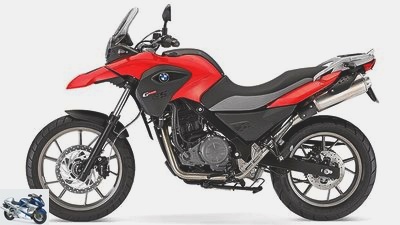
manufacturer
BMW G 650 GS: The BMW is a great rational motorcycle.
The 652 cubic centimeter single cylinder comes to life after a short push of a button. The clutch can be easily pulled and first gear engaged. From about 2000 revs the engine runs smoothly and pushes the BMW forward without any gaps. Starting at this speed, usable torque is available to easily accelerate out of the corners. The driver is welcome to leave the throttle in place until the limiter of 7400 revs has been reached.
The engine, which stands well in the forage with a measured 52 hp, develops its power powerfully and almost linearly. The maximum of 58 Newton meters also allows you to glide comfortably through the landscape with lazy shifting. The strong vibrations that make their way over the handlebar ends and footrests to the driver are annoying.
The spring elements (adjustable in the spring base and rebound stage at the front and rear) are perfectly matched to the GS concept. Despite the high level of comfort, they don’t let themselves be disturbed even when chasing the country roads. With the narrow 19-inch front tire and the 140 mm rear tire, the BMW turns neutrally and precisely in all kinds of curve radii. However, the following applies: the faster you are on the move, the more forcefully you have to apply the impulses to the handlebars so that the GS follows the targeted line. If the petrol consumption is excellent at 3.5 liters, the ABS-assisted brakes should like to grip and decelerate a little more vehemently. Otherwise: The BMW is a great motorbike of reason.

jkuenstle.de
BMW G 650 GS: The fuel is replenished from behind, the 14-liter tank is located below the seat.
Technical specifications
engine
Water-cooled single-cylinder four-stroke engine, two overhead, chain-driven camshafts, four valves, bucket tappets, dry sump lubrication, injection, Ø 43 mm, regulated catalytic converter, 400 W alternator, 12 V / 12 Ah battery, mechanically operated multi-plate oil bath clutch, five-speed gearbox, O-ring Chain, secondary ratio 46:16.
Bore x stroke 100.0 x 83.0 mm
Cubic capacity 652 cm³
Compression ratio 11.5: 1
rated capacity 35.0 kW (48 hp) at 6500 rpm
Max. Torque 60 Nm at 5000 rpm
landing gear
Bridge frame made of steel, telescopic fork, Ø 41 mm, two-arm swing arm made of steel, central spring strut with lever system, front disc brake, Ø 300 mm, double-piston floating calipers, rear disc brake, Ø 240 mm, single-piston floating caliper, ABS.
Cast aluminum wheels 2.50 x 19; 3.50 x 17
110/80 R 19 tires; 140/80 R 17
Dimensions + weights
Wheelbase 1477 mm, steering head angle 61.9 degrees, caster 113 mm, suspension travel f / h 170/165 mm, seat height 780-820 mm, weight with a full tank 198 kg, load 182 kg, tank capacity 14.0 liters.
Warranty two years
Colors yellow, white
price including Nk 7690 euros
Readings
Performance
Top speed: 170 km / h (manufacturer information)
acceleration
0-100 km / h 5.1 sec
0-140 km / h 11.3 sec
Draft
60-100 km / h 5.7 sec
100-140 km / h 7.5 sec
Triumph Street Triple
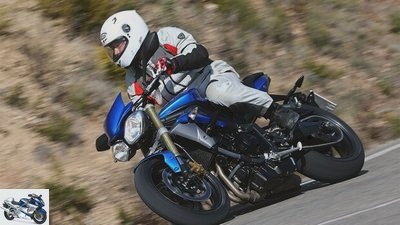
Jahn
Triumph Street Triple: The Streetie is throttled with a stop on the throttle valve mechanism.
The Streetie is throttled with a stop on the throttle valve mechanism. This has less of an impact on driving pleasure than some people think.
You can put it at the beginning: The Street Triple – extensively modeled for this season – remains an excellent motorcycle even in the 48 hp throttle version, which is compliant with the level driving license. Anyone who drives them for the first time or after a long period of abstinence gains confidence after just a few meters, begins to use their steering precision for their driving maneuvers and relies on their balance.
Nothing is missing there
What does balance mean here? Well, the streetie is easy, but not surprisingly easy to turn in, works willingly but without tipping over into deeper lean angles and signals that the limit has been reached, for example on a wet or salty road – so clearly that a careful driver can react almost instinctively. When braking in an inclined position, it does not stand up too much, when accelerating out of the curve it does not push over the front wheel. And in spite of the tight damping of the cable damping on the fork, it works cleanly on bumps in an inclined position.
So it’s no wonder that the Street Triple tempts its riders to turn the cable and make full use of the reduced angle of rotation on the throttle grip due to the stop. This fires the Triumph, whose torque is around 4000 rpm in its summit region, vehemently out of the corners. Nothing is missing there.
The cultivated three-cylinder revs up willingly at first, at around 7000 rpm it slowly becomes tough under load, for example on a long climb. And that although the maximum output is only reached at 8800 rpm. The explanation for this is provided by the torque curve, which shows a slow but steady decline from 4100 rpm. Even with the 48-hp triple, it is therefore advisable not to drive the speed too high if you want to move forward quickly. Apart from that, such a driving style would also drive fuel consumption up senselessly. 4.7 liters per 100 kilometers with a very disciplined driving style is not a model of moderation anyway. A number of other 48-hp motorcycles are much more economical and only a few are even thirstier.

Jahn
Triumph Street Triple: Instead of a pair of silencers mounted under the rear, the Street Triple got a side silencer. That didn’t harm the three-cylinder sound.
The always delicate load changes are relatively easy on the Street Triple; they are quick to react, but by no means hard. They do not cause any stress even in tight combinations of bends and on slippery roads.
In contrast to the high-quality equipped R version, the standard Street Triple brakes the front wheel with two simple floating calipers. They make it clear that they are designed for 95 or 106 hp, so they go to work harder than the brakes on entry-level motorcycles usually do. Thanks to ABS, which the Street Triple was given as part of its revision, there is no problem with emergency braking. Quite apart from the ABS, the Triumph brakes are pleasing with impeccable feedback; You believe you can feel it in the lever, how the pads rub against the discs, and you can fine-tune them accordingly.
The Street Triple is made for A2 driver’s license holders who do not want to buy a new motorcycle when purchasing the open A license, but simply want to remove the stop.
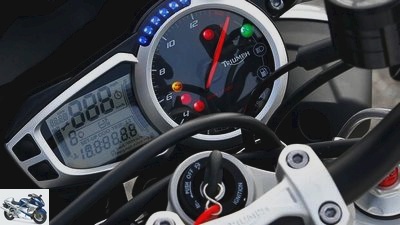
fact
Triumph Street Triple: The cockpit offers a lot of information in a small space.
Technical specifications
engine
Water-cooled three-cylinder four-stroke in-line engine, one balancer shaft, two overhead, chain-driven camshafts, four valves per cylinder, bucket tappets, wet sump lubrication, injection, Ø 44 mm, regulated catalytic converter with secondary air system, alternator 402 W, battery 12 V / 7 Ah, mechanically operated multiple discs – Oil bath clutch, six-speed gearbox, O-ring chain, secondary ratio 47:16.
Bore x stroke 74.0 x 52.3 mm
Cubic capacity 675 cm³
Compression ratio 12.65: 1
rated capacity* 35.0 kW (48 PS) at 9150 rpm (* Only the 70 kW version can be throttled to 48 PS)
Max. Torque 57 Nm at 4500 rpm
landing gear
Bridge frame made of aluminum, upside-down fork, Ø 41 mm, two-arm swing arm made of aluminum, central spring strut with lever system, adjustable spring base, double disc brake at the front, Ø 310 mm, double-piston floating calipers, disc brake at the rear, Ø 220 mm, single-piston floating caliper.
Cast aluminum wheels 3.50 x 17; 5.50 x 17
Tires 120/70 ZR 17; 180/55 ZR 17
Dimensions + weights
Wheelbase 1410 mm, steering head angle 65.9 degrees, caster 95 mm, spring travel f / r 110/125 mm; Seat height 800 mm, weight with a full tank of 188 kg, payload 189 kg, tank capacity 17.4 liters.
Warranty two years
Colors blue, black, white
price Including Nk 8435 euros
Honda NC 700 X
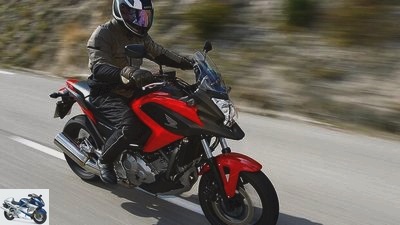
jkuenstle.de
Honda NC 700 X: Honda’s NC 700 X is predestined for newcomers and career changers – and a tempting offer for advanced users.
Adult appearance, solid all-round and everyday qualities. Hondas NC 700 X is predestined for newcomers and career changers – and a tempting offer for advanced users.
The competition and customers were amazed when Honda presented the NC 700 series at the beginning of last year. A newly developed 670 cm³ twin, inserted almost lying down in an independent framework. With 48 hp – was it foresight? – as if made for the new driving license class, not feudal, but solid. And offered at a competitive price of around 6,000 euros. The success proved Honda right. NC 700 X and S catapulted themselves instantly to the top of the Honda model range in terms of new registrations. Almost 30 percent of buyers opted for an NC in 2012. And they had good reasons for that. A seat height of 825 millimeters is also easily conquered by the inexperienced, then they will find a comfortable place.
Just do what the driver wants
With a flat steering head angle, a lot of caster and a relatively long wheelbase, the NC may not be a bustling curve sweeper, but it pulls its course steadily and steadfastly. It steers precisely, runs straight ahead, absolutely stable, just does what the driver wants and knows how to get up when braking in an inclined position: only from hearsay. In addition, the chassis presents itself in spite of the modest adjustment options – only the spring base of the shock absorber is adjustable – coordinated in a practical way.
The in-line twin also cuts a fine figure. A rev range like a car engine – the limiter waits at 6500 rpm – and a torque curve like a high plateau. Even at the lowest speeds, the twin pulls through properly and ensures brisk progress. Even if this even power development sometimes ensures that you get stuck in the limiter when you pace briskly, because the performance peak is not announced either acoustically or by a special kick. The barely readable tachometer is only of limited use when approaching the speed limit. The NC practically trains itself to shift up early, which does not detract from the relaxed, brisk locomotion.
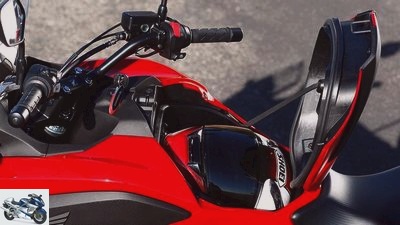
jkuenstle.de
Honda NC 700 X: The dummy tank houses a 21 liter, excellently usable storage compartment.
A nice way to deliver 48 hp. Especially since the other manners of the twin are convincing. Its sonorous thump is well dampened, as are its vibrations. In addition, the two-cylinder demonstrates pleasantly civilian drinking habits. The sixth gear, which is almost like an overdrive, also contributes to this.
The chapter on brakes is also consistently pleasing – even if the NC is “only” equipped with a single brake disc on the front wheel. Because this goes to work very confidently. The ABS regulates safely. And thanks to the combination brake, which also actuates a piston in the front three-piston brake caliper when you step on the brake pedal, the foot brake alone enables amazing decelerations. Only adjustable hand levers – red pencil or not – would have been desirable.
The series parts stand out a bit. A special treat, however, is the compartment in the dummy tank – the tank is under the seat – which easily swallows a helmet. Bottom line? Is the NC 700 X economical, powerful, comfortable and versatile – and that’s not just a pleasure for beginners.
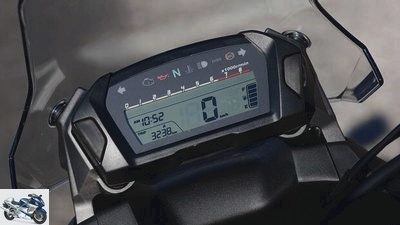
jkuenstle.de
Honda NC 700 X: The cockpit only offers the most necessary information.
Technical specifications
engine
Water-cooled two-cylinder four-stroke in-line engine, a balance shaft, an overhead, chain-driven camshaft, four valves per cylinder, rocker arm, wet sump lubrication, injection, Ø 36 mm, regulated catalytic converter, battery 12 V / 11 Ah, mechanically operated multi-plate oil bath clutch, six-speed gearbox, O -Ring chain, secondary ratio 43:16.
Bore x stroke 73.0 x 80.0 mm
Cubic capacity 670 cm³
Compression ratio 10.7: 1
rated capacity 35.0 kW (48 hp) at 6250 rpm
Max. Torque 60 Nm at 4750 rpm
landing gear
Bridge frame made of steel, telescopic fork, Ø 41 mm, two-arm swing arm made of steel, central spring strut, directly hinged, adjustable spring base, front disc brake, Ø 320 mm, three-piston floating caliper, Ø 240 mm, single-piston floating caliper, composite brake, ABS.
Cast aluminum wheels 3.5 x 17; 4.5 x 17
Tires 120/70 ZR 17; 160/60 ZR 17
Dimensions + weights
Wheelbase 1540 mm, steering head angle 63.0 degrees, caster 110 mm, spring travel f / h 154/150 mm, seat height 825 mm, weight with a full tank 218 kg, payload 209 kg, tank capacity 14.1 liters.
Warranty two years
Colors gray, black, white
price including Nk 6495 Euro
Readings
Performance
Top speed: 160 km / h (manufacturer information)
acceleration
0-100 km / h 5.5 sec
0-140 km / h 12.0 sec
Draft
60-100 km / h 7.6 sec
100-140 km / h 10.3 sec
Kawasaki Ninja 300

jkuenstle.de
Kawasaki Ninja 300: With a fresh look and larger displacement, the Ninja 300 appeals to sports freaks – even if the 39 hp Kawa cannot exhaust the 48 hp limit.
The speaks with a fresh look and larger displacement Ninja 300 the sports freaks – even if the 39 hp Kawa cannot exhaust the 48 hp limit.
Bonsai Racer goes one step further
Head down, fold your elbows and full throttle. Right, left, right, the bright green speedster threads its way through the combination of curves as effortlessly as a sewing machine along a zigzag seam, accentuating the brisk swing with the high-speed sound from its two-cylinder engine. With its nimble handling, easy-to-turn parallel twin and, above all, a sporty, grown-up look, the Ninja 250 R, presented in 2008, immediately created a large fan base. With the aforementioned strengths, the bonsai racer, which has been heavily revised for the 2013 model year, is still convincing – and goes one step further.
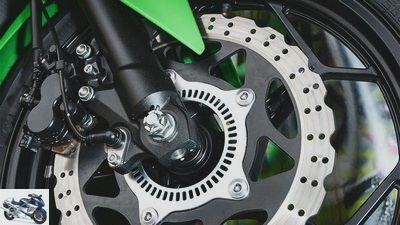
jkuenstle.de
Kawasaki Ninja 300: With ABS as standard, the 300 Ninja takes on new things and preserves the tried and tested with a high-revving engine (limit: 13,000 rpm).
Because a 7.8 millimeter longer stroke increases the displacement to 296 cm³, giving the propellant 6 hp more power (39 instead of the previous 33 hp) and – even more important – 25 percent more torque. In fact, the little motor, previously known as the barrel organ, already tackles the engine from 6000 / min (previously 8000 / min) thanks to the displacement increase, now also pushes ahead properly below the five-digit speed range and still cheers unabashedly for the brisk pace up to 13,000 tours.
And because niceties such as the clutch with servo and anti-hopping function, the rear tire widened to 140 millimeters, the significantly more angular and modern design of the fairing, rear and exhaust, and even more the standard ABS upgrade the bonsai hit in many areas , the little ninja will probably still be at the top of the fan favorite. At least they will forgive her for not being able to exhaust the newly set power limit of 48 hp with her displacement handicap. Because one thing is certain even with less tasty: The ninja will not let itself get down when it comes to the curve twist.
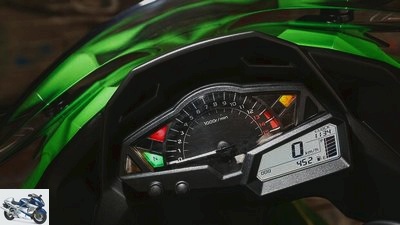
manufacturer
Kawasaki Ninja 300: The cockpit of the Kawa.
Technical specifications
engine
Water-cooled two-cylinder four-stroke in-line engine, two overhead, chain-driven camshafts, four valves per cylinder, bucket tappets, wet sump lubrication, injection, Ø 32 mm, regulated catalytic converter, alternator 322 W, battery 12 V / 8 Ah, mechanically operated multi-disc oil bath clutch (anti- Hopping), six-speed gearbox, O-ring chain, secondary ratio 42:14.
Bore x stroke 62.0 x 49.0 mm
Cubic capacity 296 cm³
Compression ratio 10.6: 1
rated capacity 29.0 kW (39 hp) at 11,000 rpm
Max. Torque 27 Nm at 10000 rpm
landing gear
Bridge frame made of steel, telescopic fork, Ø 37 mm, two-arm swing arm made of steel, central spring strut with lever system, adjustable spring base, front disc brake, Ø 290 mm, double-piston floating caliper, rear disc brake, Ø 220 mm, double-piston floating caliper, ABS.
Cast aluminum wheels 2.75 x 17; 4.00 x 17
Tires 110/70 ZR 17; 140/70 ZR 17
Dimensions + weights
Wheelbase 1405 mm, steering head angle 63.0 degrees, caster 93 mm, spring travel f / r 120/130 mm, seat height 785 mm, weight with a full tank of 177 kg, load 177 kg, tank capacity 17.0 liters.
Warranty two years
Colors green, black,
price Including Nk 6475 euros
Readings
Performance
Top speed: 170 km / h (manufacturer information)
acceleration
0-100 km / h 6.1 sec
0-140 km / h 13.8 sec
Draft
60-100 km / h 7.7 sec
100-140 km / h 9.7 sec
Yamaha TMax 530 ABS
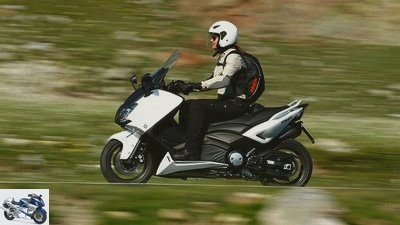
Gargolov
Yamaha TMax 530 ABS: Tens of thousands of southern Europeans can’t be wrong – or can they? Is the TMax sports scooter a useful alternative to a motorcycle for beginners?
Tens of thousands of southern Europeans can’t be wrong – can they? Is the sports scooter TMax a viable alternative to a motorcycle for beginners?
It came, turned it up and won: Since its appearance in 2000, the TMax has been selling like sliced bread in southern Europe, and it has had around 200,000 fans in Italy alone. And not ambitious retirees: the typical customer keeps a keen super athlete for the racetrack or a travel enduro for the tour with his buddies, while he leaves the TMax on in everyday life.
Doesn’t spoil when you start the traffic light
In the city, the two-cylinder also plays its trump card. It combines the space-saving advantages of single-lane vehicles with the comfort of a car, with its 218 kilograms it jumps casually from lane to lane, nimbly meanders through traffic in columns and does nothing at the start of traffic lights. Thanks to the lively 47 HP engine and the automatic transmission, there is a touch of driving fun even in the thickest of crowds, and the ample storage space under the seat is more than welcome on a shopping tour. Finally, the low seat height of just under 80 centimeters gives beginners the security they need on their first few kilometers in two-wheeled life.
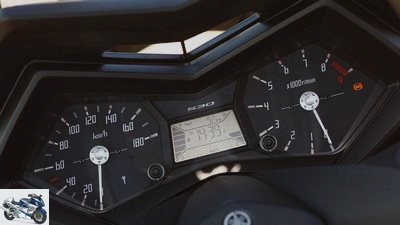
manufacturer
Yamaha TMax 530 ABS: The cockpit is reminiscent of the automotive industry and offers a lot of information.
The TMax is also reasonably spirited outside of town. With its sporty suspension, it takes corners confidently and allows you to take a good lean in solo operation. The fairing protects quite well against wind and weather, the slightly bent seat position and the comparatively low handlebars convey the pleasant feeling of sufficient control, which is reinforced by the powerful brakes and the ABS.
And yet: In the long run, the TMax lacks real driving pleasure on the country road. The 15-inch wheels are too small, the chassis too rough on bumpy roads, too long and heavy the whole load, too spongy the handling in general. Not to mention the exorbitant price of 11,345 euros; for so much money you can get a lot of motorcycles elsewhere. Nevertheless, the southern Europeans are not wrong: The TMax has its justification – as a second vehicle for the city.

manufacturer
Yamaha TMax 530 ABS: Of the TMax’s nominal 47 hp, only 40 reach the rear wheel via the toothed belt.
Technical specifications
engine
Water-cooled two-cylinder four-stroke in-line engine, a balance shaft, two overhead, chain-driven camshafts, four valves per cylinder, bucket tappets, dry sump lubrication, injection, Ø 38 mm, regulated catalytic converter, 350 W alternator, 12 V / 9 Ah centrifugal clutch, stepless automatic belt , Toothed belt, secondary transmission 2.262.
Bore x stroke 68.0 x 73.0 mm
Displacement 530 cm³
Compression ratio 10.9: 1
rated capacity 34.2 kW (47 hp) at 6750 rpm
Max. Torque 52 Nm at 5250 rpm
landing gear
Tubular frame made of aluminum,
Telescopic fork, Ø 43 mm, drive unit swing arm, suspension strut, double disc brake at the front, Ø 267 mm, four-piston fixed calipers, disc brake at the rear, Ø 282 mm, single-piston floating caliper, ABS.
Cast aluminum wheels 3.50 x 15; 5.00 x 15
Tires 120/70 R 15; 160/60 R 15
Dimensions + weights
Wheelbase 1580 mm, steering head angle 62.0 degrees, caster 95 mm, spring travel f / r 120/116 mm, seat height 780 mm, weight with a full tank 218 kg, load 197 kg, tank capacity 15.0 liters.
Warranty two years
Colors gray, black, white
price including Nk 11345 Euro
Readings
Performance
Top speed 161 km / h (manufacturer information)
acceleration
0-100 km / h 7.4 sec
0-140 km / h 16.3 sec
Draft
60-100 km / h 4.0 sec
100-140 km / h 8.9 sec
throttling
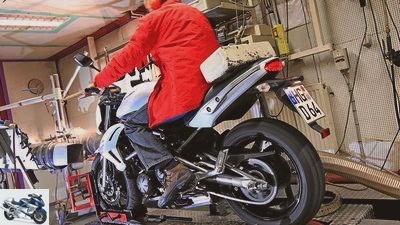
Gargolov
If you are a beginner who is only allowed to ride a motorcycle with a maximum of 48 hp, you can still get a more powerful bike. However, this must then be throttled.
If you have a level driving license and still want to drive a motorcycle that the manufacturer does not offer as a 48 hp version, you don’t need to despair: Technically, every motorcycle can be reduced to the prescribed power. In the past, an aperture was installed for this purpose, which reduced the passages of the carburettor so much that correspondingly less mixture was fed into the combustion chamber. With modern injectors, the throttling works mechanically by restricting the throttle grip or electronically by intervening in the engine mapping.
Throttle kits for over 200 motorcycles
Due to the horsepower limits for driving licenses and insurance, an accessory industry has developed that offers throttle sets for numerous models. Alpha Technik from Stephanskirchen in Upper Bavaria is the market leader for power reductions to 35 kW in Germany. For around 100 euros each, newbies can choose from throttle kits for over 200 motorcycles. “We try to react quickly to new models,” says managing director Frank Seiler. Four weeks after a vehicle was launched on the market, his company usually developed a power reduction, says Seiler. This is followed by noise and emissions tests as well as a TuV acceptance – after that the throttle is free for sale. Once on the market, Alpha Technik issues a separate report for each chassis number, as the legislature wants. A throttle must therefore theoretically stay in the same motorcycle for its entire life.
Like most of its competitors, Alpha Technik relies exclusively on mechanical throttling: A metal part limits how far the driver can turn the throttle. Using test bench measurements, the Alpha Technik engineers find out beforehand how many millimeters of gas travel the respective engine can achieve 35 kW – and precisely after this distance, they construct the stop for the model. With engines in the lower and medium power range, driving comfort can be largely maintained while complying with the legal requirements.
Intervention in the control unit can lead to side effects
Sophisticated superbike engines, on the other hand, produce the maximum 35 kW almost at idle: “If only two or three millimeters of gas travel remain, we’ll let it go. Mechanical throttling then simply makes no sense, ”says Seiler. Even with models, which experience shows that young beginners very rarely buy, Seiler and his team do without development work: “We offer throttles for almost every motorcycle, but with a few models it’s not worth it. There is simply no market for a Gold Wing with 48 hp. “
Manufacturers reduce the performance of their own machines if necessary by mapping the motor. However, the third-party providers have so far not really dared to approach the control units. Above all, this has to do with the warranty: an intervention in the control unit can quickly lead to nasty side effects, such as an engine that is running too lean or too rich. In the long term, there is a threat of damage. Unlike if you simply cut the drive a little in the already existing power spectrum: “I am not aware of any case where a vehicle has been damaged by a mechanical throttle from us,” says Seiler.
Prices and offers for top-proven A2 motorcycles in Germany
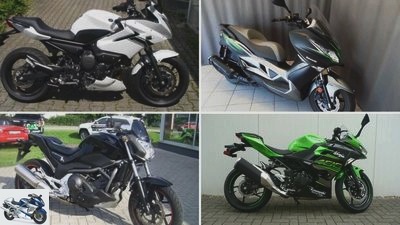
1000PS marketplace app
Top-proven A2 motorcycles in price comparison
Nowadays, newcomers to the A2 driving license are faced with an unbelievably large range of 48HP motorcycles. On the one hand, the used market is growing continuously; on the other hand, the new vehicle offers in the A2 league are becoming more and more attractive. Here we give you an overview of the prices and offers of the most tried and tested motorcycles and scooters for sporty A2 pilots from Germany who want to be on the move in a contemporary way: Prices of proven A2 motorcycles in Germany
Related articles
-
Test of 48 HP motorcycles 2017 for A2 driver’s license holders
r-photography.info 42 pictures r-photography.info 1/42 In the comparison test, the models Honda CB 500 F, KTM 390 Duke, Ducati Monster 797, Honda Africa…
-
Drive 125cc with the car driver’s license without a test
Honda 20th pictures KTM 1/20 1st place: KTM 125 Duke with 5,334 new registrations in 2020. Yamaha 2/20 2nd place: Yamaha MT-125 with 2,439 new…
-
Diary driver’s license training class A
Natalie Diedrichs 13th pictures Natalie Diedrichs 1/13 Volunteer Natalie Diedrichs is doing her class A driving license. On motorradonline.de, she…
-
Electronic driver assistance systems for motorcycles
Yamaha 35 pictures www.factstudio.de 1/35 How things are going? It was a long way from the almost purely mechanical cockpit of the Yamaha SR 500 to the…
-
48 HP motorcycles with Euro 5 for A2 driving license
manufacturer 89 pictures manufacturer 1/89 AJP PR7. Open power: around 50 hp. Aprilia. 2/89 Aprilia Tuono 660. Power open: 95 hp. Benelli 3/89 Benelli…
-
Honda 125cc driver’s license extension all-inclusive
Honda counselor Driving experience & Driving tips Honda 125cc license extension all-inclusive Honda cooperates with driving safety center Complete…
-
Driver assistance systems for motorcycles
Hirano Ami counselor Driving experience & Driving tips Driver assistance systems for motorcycles Assistance systems For comfort and security Motorcycles…
-
In Singapore to get a driver’s license without an examiner
SSDC counselor traffic & business In Singapore, even without an examiner for a driver’s license Without an examiner to the driver’s license Singapore…
-
Tattooed Iranians have to take a psychological test before the driver’s license test
BMW counselor traffic & business Tattooed Iranians have to take a psychological test before the driver’s license test Driving license hurdle for tattooed…
-
Driver’s license compulsory exchange deadline until 2033
Fotolia, Bundesdruckerei, archive counselor traffic & business Driver’s license compulsory exchange deadline until 2033 Driver’s license compulsory…